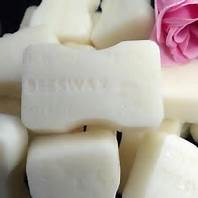Artifical Raspberry Fragrance






Artificial Raspberry Fragrance
- if you have an adverse reaction to a cosmetic or toiletry there is a good chance that colorants or fragrance chemicals are responsible. The following may help to explain why. Many cosmetics come in both a normal ad hypoallergenic form. Commonly, both products have the same ingredients but the hypoallergenic version contains no colorants or fragrance chemicals, and is sold in smaller containers that cost more. Many artificial flavors and fragrances contain a large number of fragrance chemicals.
- Minor additions or variations to this recipe may be necessary to compensate for any unpleasant odors produced by the other ingredients in te product. If this were the case, the recipe could include a larger number of hazardous, artificial chemicals.
-
100 parts 4-(4-Hydroxyphenyl)-2butanone 1,8,6 30 parts 3-Hydroxy-2-methyl-4pyrone (Maltol) 1,5,9,12 20 parts 4-Hydroxy-3Methoxybenzaldehyde (Vanillin) 2,5,9 1 part a-Ionone 1,4,5,9,10,11,12 1 part Methyl sulfide 1,4,5,9,10.11.12 1 part 2.5-Dimethyl-N-(2-pyrazinyl) pyrrole 9,12
- Irritating to eyes, respiratory system and skin.
- Harmful if swallowed. Irritating to eyes.
- May cause sensitization by inhalation and by skin contact.
- Risk of serious damage to the eyes.
- In case of contact with eyes, rinse immediately with plenty of water and seek medical advice.
- Wear suitable gloves and eye/face protection.
- Wear suitable protective clothing, gloves and eye/face protection
- Do not breathe dust.
- Wear suitable protective clothing.
- Do not breathe vapor.
- Keep away from sources of ignition-No smoking.
- Harmful if swallowed
- When a scent or a mixture of fragrance chemicals are added to a cosmetic or toiletry, this is indicated on the list of ingredients by the word "Fragrance" in the USA, or "parfum" in the EU.
- The fragrance may be a natural plant extract or a cocktail of several artificial fragrance chemicals.
- There are 932 fragrance chemicals listed by the EU Commission and none of these has to be named separately on the list of ingredients.
- A perfumer will use his/or her experience, skill and imagination to blend these fragrance chemicals to produce the desired effect.
- However, they cannot exercise creative talents with complete freedom, as they must always consider the cost of individual fragrance chemicals - using the less expensive options where ever possible.
- They must also ensure the fragrance chemicals are compatible with the other ingredients in the product.
- Few perfumes contain less than 20 fragrance chemicals and many have more than a hundred.
- They are used in minute quantities but many of them are known to have irritant, harmful, or toxic properties, so it is no wonder that many adverse reactions to cosmetics are linked to these fragrance chemicals.
- Have a look at the recipe for raspberry fragrance to see why.
- If you have an adverse reaction to a personal care product, try using one that has no added fragrances.
- Be warned, however, "fragrance free" or "unscented" written on the packaging is not guarantee that the product is for from these ingredients.
- A small amount of fragrance may be added to cover up the unpleasant smells of the other ingredients.
Reference: Cosmetics Unmasked : Dr Stephen & Gina Antczak
Articles-Latest
- 8 common mistakes that could be making your dry lips worse
- Dermatologist's insight on shower frequency without harming skin
- ‘Making Black More Beautiful’: Black Women and the Cosmetics Industry in the Post-Civil Rights Era
- A damaged skin barrier can leave you dry, itchy or oily. So, how do you fix it?
- What is collagen and why is it so popular in the beauty industry?
- Skin icing's not just for summer – this cryotherapy technique will get you party season ready
- How much sunscreen should you use and how often do you need to apply it?
- Are AHAs Safe?
- EXFOLIANTS - Cosmetics Unmasked
- ASTHMA - Toxic Beauty
- PHOTOSENSITIVITY - Toxic Beauty
- How to Tighten Your Loose Skin After Weight Loss
- Everything You Need To Know Before Getting A Septum Piercing
- What you should know about treating rosacea in darker skin tones
- Shampoos and Conditioners Designed to Soothe Dry, Itchy Scalps
- 3 things an expert wants you to know before getting filler
- Dissolving filler: everything you need to know
- How thread lifts differ to facelifts – and filler injections
- People are using face tape to minimise wrinkles, but does it work? After asking a plastic surgeon, I tried it for myself
- Reality of Black beauty influencing - making foundation with eyeshadow and unequal pay
Cosmetic ingredients
LOGIN
Who's On Line
We have 85 guests and no members online
Articles-Most Read
- Home
- Leucidal
- White Bees Wax
- Cosmetic Preservatives A-Z
- Caprylyl Glycol
- Cosmetics Unmasked - How Safe Are Colorants?
- Cosmetics Unmasked - Choosing Ingredients
- Cosmetics Unmasked - Colorants And Fragrances
- EcoSilk
- Toxic Beauty - Who's Looking At Cosmetics?
- Cosmetics Unmasked - Fragrances
- Microbes and Cosmetics
- Chemicals Lingering In The Environment
- Microbes and Safety Standards
- Toxic Beauty - Hazardous To Your Health
- Potassium Sorbate
- Yellow Bees Wax
- Synthetics In Cosmetics - The Industry Fights Back
- Fresh Goat's Milk Soap
- Active Ingredients
- What's Happening in the USA - Cosmetic Regulations - Toxic Beauty
- Cosmetics Unmasked - Listing Cosmetics
- Natural Waxes A-Z
- Toxic Beauty - Cocktails and Low Doses
- Natural Butters A-Z



